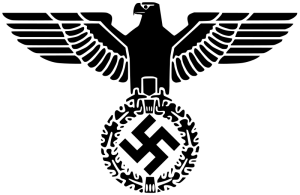Deutsch-English: Americans had concentration camps in the USA for Germans - List of internees - Amerikanische KZs fuer Deutsch-Amerikaner waehrend und nach dem Krieg - Liste der Gefangenen.
AMERIKANISCHE KONZENTRATIONSLAGER FUER DEUTSCHE - Namensliste unter No. 4
*
German-Latin American Internees in the U.S.A.:
http://www.germanvictims.com/2014/12/19/german-latin-american-internees/
ABOUT 400,000 GERMAN-AMERICANS OR GERMANS WERE PUT INTO THE AMERICAN CONCENTRATION CAMPS. MANY WERE EVEN HAULED FROM SOUTH AMERICA AND INCARCERATED IN THE U.S. HERE IS ONE STORY OF MANY. YOU NEVER EVER HEAR ABOUT IT, DO YOU. SOME GERMANS WERE LOCKED AWAY FOR YEARS. OF COURSE THEY LOST THEIR BUSINESS AND THEIR PROPERTIES. DID JEWS BUY IT CHEAPLY? WAS THEFT THE IDEA?
The Eiserloh Story
Mathias and Johanna Eiserloh met in Johanna’s hometown of Idstein, Germany after WWI, where Mathias was a civil engineering student. They shared a dream of emigrating to America and did so in 1922. They brought with them the hopes and dreams held by most immigrants to this country—to live, work and raise a family in freedom. Mathias’ two sisters and three of Johanna’s siblings joined them in America soon after.
Life was not as rosy in America as they had imagined it. They endured the struggles typically faced by new immigrants while learning the new language, finding employment and adjusting to the cultural and social differences. They accepted jobs during those early years wherever they could find work. Mathias even worked briefly in the coalmines of West Virginia. Eventually, Mathias found a job in his chosen profession. In 1929, they rewarded themselves by vacationing in Europe, traveling and visiting family. In October, days before their return, the stock market crashed. They came home to face financial turmoil and the Depression. Eventually, after struggling to recoup their losses, they purchased two acres of land in a rural area outside Cleveland, Ohio. Mathias, who had also studied architecture, designed and drew up plans for a home, which the couple literally built with their own hands, while living in a tent on the property. With the help of friends, they dug the basement, mixed and poured cement for the foundation, and built a fine house. They bore three children between 1930 and 1941 – all U.S. citizens.
During this time, Johanna also raised a flock of chickens and started a small business selling the eggs and hens. Life was good, the future looked bright, and the children flourished. They attended a German social club largely comprised of other engineers and their families with whom they enjoyed German music and dances and shared common experiences. Such clubs also served as networks for finding jobs and to give support to member families in times of need. While the men would discuss their jobs and politics over a stein of beer and a cigarette, this club was strictly social. It was not a political organization nor did it have any political agenda. Unfortunately, unlike their siblings, the Eiserlohs, busy raising their children and working hard, had not pursued their long-standing plan to apply for US citizenship. Naively, they had considered themselves thoroughly American since their arrival in this country. They were to learn quickly that this mistake and, apparently, their club membership, would cost them everything.
Days after the attack on Pearl Harbor, on December 9, 1941, life as they had known it was destroyed forever. Mathias was suddenly arrested by the FBI at his job and jailed in Cleveland. Their savings were frozen. He was questioned about his membership in the German club, their families here and in Europe, his friends and his job. The government ordered his internment. His arrest and loss of income left Johanna and her three children, ages 1, 6 and 11, destitute. Neighbors and friends suddenly treated them with astonishing coldness. Johanna could not ascertain why Mathias was arrested or when he would be released. Johanna’s customers no longer bought her chickens and eggs. No one believed that an innocent man would be jailed. They suspected that Mathias “must have done something.” The children were harassed with nasty taunts and insults from schoolmates referencing their German heritage.
In desperation, Johanna was forced to sell their home after a few months. Fearing the proceeds from the sale would be frozen, Johanna insisted on a cash sale and found it necessary to accept the paltry sum offered by an opportunistic buyer. Before she could move out, a masked intruder attacked her during the night, demanding “the money” from her. She fought him off with a piece of lead pipe, which she kept under her pillow for protection. Just days earlier Johanna was unnerved because someone shot their two German shepherds. Terrified and badly shaken, she was left partially paralyzed. Mathias’ sister gave the family shelter in her cellar and took care of the children while Johanna slowly recovered. A basement fire forced the family to find yet another home. The children were traumatized and missed their father terribly. Despite Johanna’s many pleas, the government gave no indication when or if he would be released. Reluctantly she petitioned the government to be allowed to join him in the camp, believing the family would be better off together.
After two long years of suffering the strain and hardship of separation, the family was reunited at the Crystal City, Texas internment camp. Although Johanna and the children were “voluntary internees”, they could not leave “voluntarily.” They lived in small quarters with very basic necessities. They soon learned from other families in the camp that their story was not unique. Most had been suddenly uprooted and imprisoned, losing home and possessions. Becoming increasingly despaired and bitter, they finally agreed to repatriate to Germany in response to the more than subtle pressures by government officials. In January 1945, they were transported to NY Harbor to board the S.S. Gripsholm under a wartime exchange program between Germany and the United States, which provided for U.S. citizens held in Germany to be released in exchange for “Germans” sent back from the United States. The “Germans” being exchanged included many US-born children and spouses who were either US-born or naturalized citizens.
Johanna, age 44, was nine months pregnant when they left Crystal City. She gave birth to an infant son, Günther, on January 4, 1945, on the train to New York Harbor and the SS Gripsholm. The child’s birth certificate lists his place of birth as New Orleans, LA. Although extremely weak from travel and the recent birth, Johanna and her family had to board the SS Gripsholm on January 6, 1945 and endure the fourteen-day stormy crossing through the Atlantic war zone. She and her baby, both weak and ill, remained in sickbay throughout the entire voyage. The older children were now 14, 9 and 4 years old.
They and several hundred repatriates disembarked the SS Gripsholm at Marseilles, France, after a minor incident with a harbor mine. They were taken by train to Switzerland. While awaiting the exchange, the crates containing the family’s belongings, including seasonal clothing carefully selected by Johanna, and items they could use to barter for food, were stolen. The family now had only the clothes they wore and one small suitcase of miscellaneous things.
The exchange took place at Bregenz in early February 1945. The “Germans” were brought to the border on the back of a flatbed truck in small groups. The Eiserlohs waited for hours in the cold until it was their turn to cross. Johanna, carrying the baby, walked with Ensila, following Mathias, Lothar and Ingrid. Their papers were carefully checked and heads counted. Two adults, two male children, two female children. The children, all U.S. citizens, were exchanged for other U.S. citizens who walked out to freedom. On the other side, they climbed back onto the open truck and were taken to Aschaffenburg, a town almost completely destroyed by bombs.
Now left on their own and struggling with the sickly infant, the family slowly made their way north across war-ravaged Germany. Amidst bombings and air raids, in dead of a record-breaking winter, they traveled by train when possible, but often they had to walk because the railways were destroyed. Food was hard to come by and they could only hope to find shelter among Johanna’s relatives. Their relatives did not expect them, as no communication had been possible since the start of the war.
During the last leg of their journey, US planes strafed their train. Frightened, they huddled under the seats until train stopped. They ran with the other passengers into the adjoining woods as the planes continued gunning the train. An anti-aircraft gun on the last train car was put into action and the family watched, with mixed emotions, as smoke filled the sky where two of the American planes were shot down.
They arrived in Idstein during the first days of March, hungry and exhausted from two months of difficult journeying. They were greeted without enthusiasm and felt most unwelcome. The relatives, like the rest of the country, did not have enough food for themselves, never mind another family of six. Johanna’s aging parents could only offer them a small corner in their cellar for living quarters. What little food could be had was primarily bartered on the black market. The family was by now suffering the symptoms of malnutrition. They were often ill treated, having just arrived from America, and were under constant suspicion by local Nazis and townspeople who could not comprehend why they had returned from America at this time.
Within two weeks of their arrival, six overzealous members of the SS severely beat Mathias in their basement home in full view of his terrified wife and children. The Gestapo arrested Mathias and took him away to an unknown prison, suspecting him of being an undercover spy for the advancing US Military. The family did not know if he was still alive until the end of the war some months later, when he was found, thoroughly questioned and released by the occupying US Army. Ironically, the government that imprisoned him in America and was responsible for his family’s predicament probably saved his life. Following the war, the family moved to small a two-room barracks facility. It was sparsely furnished, with beds in one room, a table, four chairs and a small coal stove in the other. It had a sink with cold running water in one corner but no kitchen. From here the family tried to rebuild their lives.
Their application for re-entry to the U.S. immediately after war was repeatedly denied. Finally, in 1947, the two eldest children, Ingrid and Lothar, then ages 12 and 17, were allowed to repatriate to the US with Mathias’ sister agreeing to act as their guardian. They did not see their family again for eight years. The Eiserlohs continued to endure years of hunger and deprivation while making countless applications to re-enter the United States. Lothar joined the US Air Force after completing high school and was granted a security clearance to receive nuclear weapons training. Perhaps not coincidentally, his parents and siblings were finally granted re-entry visas to the United States shortly thereafter, in November 1955.
Now 60 years old, Mathias couldn’t find work as a civil engineer. He accepted a low-paying job from which he was forced to retire at 62. After struggling several more years to provide for his wife and two teenagers, he died at age 65 of heart failure. Johanna became a citizen in 1961, and supported herself with the meager earnings from odd jobs until the age of 89 when Alzheimer’s robbed her of all past memories. She died in January 1997, at the age of 96. Three children survive today. Günther, who began his life on a train to New York, perished in an automobile accident at the age of 22, after his discharge from the U.S. Navy. The physical, emotional and psychological trauma the family suffered throughout the years of separations and a deprivation had long lasting effects on all of them and is still being felt by the remaining three children.
Ingrid, Lothar and Ensila are still trying to learn why their father was interned but have as yet not been successful in obtaining the government records, which would hopefully answer their questions. They now tell their story to help others understand the travesties permitted under America’s “enemy alien” laws in the hope that it will lead to a better understanding and the instituting of measures that will prevent such a recurrence. Those laws, which some argue are necessary during wartime, do not adequately protect innocent immigrants from flagrant miscarriage of justice by overzealous government officials operating under the guise of patriotism.
http://www.foitimes.com/internment/Eiserloh.htm
For more stories go to the above link.
Camps for Germans (U.S. citizens) from the US and Latin America
1) Coming early 2014 - a film about German internment in the USA
http://www.childrenofinternment.com/?p=392
2) PERSOENLICHE GESCHICHTEN DER DEUTSCHEN - LEIDER NUR AUF ENGLISH - Personal Stories of internment can be read here:
http://www.foitimes.com/index_files/Personal_Stories.htm
3) The camps
German Concentration Camps in the USA:
http://www.foitimes.com/index_files/Books_Journals_Media.htm
http://www.nexusboard.net/showthread.php?siteid=6365&threadid=297166
4) NAMEN DER DEUTSCHEN IN AMERIKANISCHEN KONZENTRATIONSLAGERN:
Some Listings of Internees (Names and age) in some of the U.S. Internment Camps
source: http://www.foitimes.com/internment/CampLists/CampLists.htm
Crystal City, Texas February 29, 1944
Crystal City, Texas December 31, 1945
Crystal City, Texas December 31, 1946
Ellis Island, New York Harbor, NY. Multiple lists from February 29, 1944 through December 31, 1945
Fort Lincoln, Bismarck, North Dakota February 29, 1944
Fort Lincoln, Bismarck, North Dakota December 31, 1944
Fort Stanton, New Mexico December 31, 1944
Seagoville, Texas December 31, 1944
Stringtown, Oklahoma May 10, 1943 (transfers) and other lists







